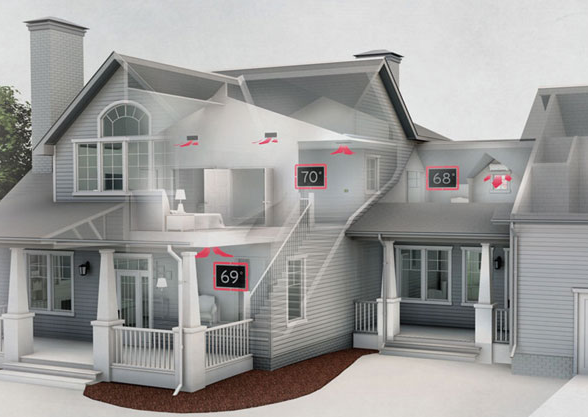What Does it Mean to be Energy Efficient?
Ductless heat pumps can operate using 25% to 50% less energy that electric resistance and forced air systems, making them more energy efficient.
Ductless Comfort Technology ensures that the systems use the exact amount of energy needed to cool or heat an area. Each unit automatically responds to temperature changes. This means that you will be able to reduce your energy consumption and save even more.
Products that meet strict energy efficient requirements determined by the EPA and the US Department of Energy that do not compromise the performance and features of a product receive the Energy Star logo. For more info visit www.energystar.gov.
Three key factors account for the high energy efficiency of ductless heat pumps:
- Ductless heat pumps allow the user to control each heating/cooling zone independently, eliminating the costly over-heating and cooling common to central air systems. Why pay to heat or cool rooms that are not currently occupied? While central air systems lose as much as 30% efficiency through air leaks and conduction in the ductwork, ductless heat pumps distributing air directly into each zone, resulting in 25% greater efficiency.
- Ductless heat pumps use inverter-driven variable speed compressors that allow the system to maintain constant indoor temperatures by running continuously at higher or lower speeds. Thus, the system can ramp-up or down without great losses in operating efficiency, avoiding the energy intensive on/off cycling common in electric resistance and forced air systems.
- Modern ductless heat pumps have ultra-high Seasonal Energy Efficiency Ratios (SEER) between 16 and 22, and Heating Seasonal Performance Factors (HSPF) between 8.5 and 11.
So what are SEER and EER Ratings anyways?
The Seasonal Energy Efficiency Ratio (SEER) measures air conditioning and heat pump cooling efficiency, which is calculated by the cooling output for a typical cooling season divided by the total electric energy input during the same time frame. A higher SEER rating means more energy efficient. For more about SEER rating check AHRI Directory of Certified Product Performance
The Energy Efficiency Ratio (EER) of a cooling unit is determined by the output cooling divided by the electrical power input. As opposed to SEER which is calculated over a range of outside temperatures, EER is typically determined by a set outside air temperature, a set inside air temperature and a 50% relative humidity
What about a BTU?
One British Thermal Unit (BTU) represents the amount of heat required to raise or lower the temperature of one pound of water one degree Fahrenheit.


Leave a Reply